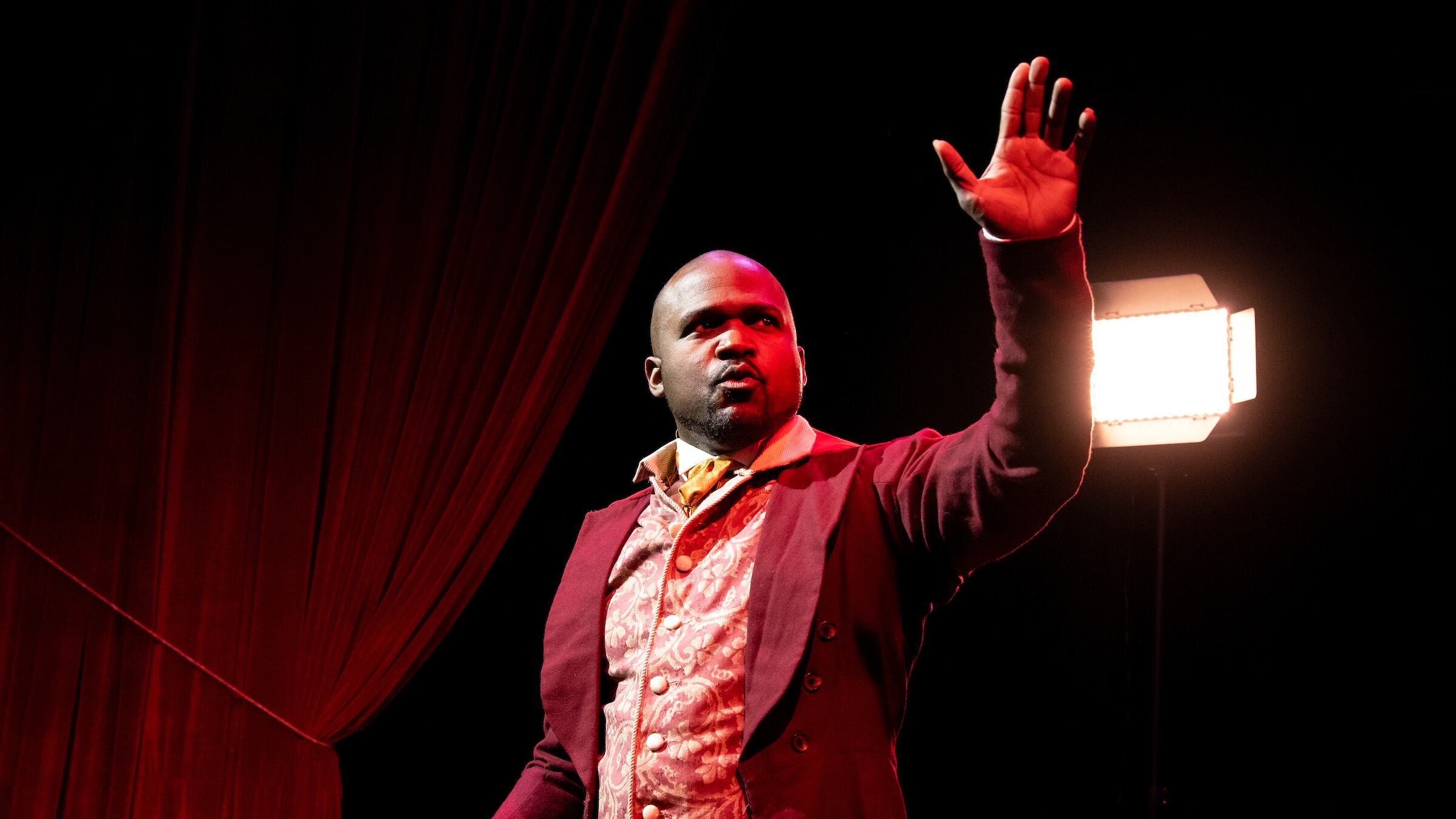Towards the end of Bag&Baggage Productions’ Red Velvet, a wall of pictures begins to talk. In director Nik Whitcomb’s powerful version of the play, the wall is actually an open structure hung with fancy picture frames, suggesting traditional upper-class British décor, complete with portraits of privileged ancestors.
When three characters stand with their faces centered in the frames and repeat lines they’ve spoken earlier in the play, the production evokes the idea that the past will continue to haunt us in the present.
The past—and what we can learn from it—is a theme that runs throughout Lolita Chakrabarti’s 2012 script, which is based on the real life of American-born actor Ira Aldridge. In 1833, as Britain was about to pass its Slavery Abolition Act, Aldridge became the first Black man to star as Othello at London’s Covent Garden.
Red Velvet takes these facts and imagines the reaction to Aldridge’s presence as a microcosm of the roiling politics of the day. While rioters for and against abolition can be heard out in the street, the Othello cast members are similarly divided.
One of those actors, Bernard Ward (Stan Brown), expresses his opinion in a persnickety English accent that makes King Charles sound like a country bumpkin. After insisting the country’s economy relies on slavery, he orders Connie, a Jamaican-born maid (Victoria Alvarez-Chacon), to serve his tea with “buckets of sugar,” in defiance of those forgoing the sweetener in support of abolition.
Despite the intensity of the play’s material, Whitcomb is adept at emphasizing its humorous moments, beginning with the instant Aldridge (a compelling Eric Zulu), with head held high and heart open, confidently strides into the theater for his first rehearsal. The white Othello actors literally stop in their tracks and stare at him with open mouths. Even Connie, who before now has kept her face expressionless and her eyes down, gasps then smiles to herself.
Some of the characters, such as Ellen Tree (an effervescent and nuanced Elizabeth Jackson), are open to Aldridge taking over the part, which had been played by the famous white actor Edmund Kean before he collapsed onstage. Although Tree is shocked that her Desdemona will now be married to an Othello who is actually Black—as opposed to wearing blackface—she quickly comes to admire and is inspired by Aldridge’s professionalism.
One comic scene involves Tree beginning a rehearsal by acting the way she always has, using ridiculously exaggerated poses and gestures. With melodramatic music playing in the background, she seems to be channeling the comically mannered acting style in silent movies. Aldridge, who believes in a more modern, naturalistic method of performing, suggests she try to convey honest emotion, and the sparks of their mutual commitment to improving their craft is a joy to watch.
Such joy, though, can’t last. Although the Othello audience gives Aldridge a standing ovation—and, as proof, the audience of Red Velvet gets to hear their applause and cheers—the press skewers his performance. Quoting an actual article, one reviewer says Aldridge’s African features prevent him from speaking proper English.
The tragedy heightens when his friend, theater manager Pierre Laporte (Joseph Hugh-Martin Murley), fires him from the show. In the scene, mournful music plays as the two men slowly enter the stage and stop on opposite sides. Soon, they are arguing with a building ferocity that has the audience of Red Velvet holding their breath.
As potent as Aldridge’s story is, Chakrabarti packed her script with reflections on a plethora of other issues (including class, gender and sexual orientation, to name a few). The connection between these issues and race is valid (for instance, Laporte, as a gay man, lives a perilous existence in 1833 England). But despite the skillful and spirited acting of the entire Red Velvet cast, the script starts to drag a bit when Chakrabarti devotes large sections of her two-plus-hour play to these other stories.
Such minor flaws, though, can’t diminish the power of the production. Especially when the once-optimistic Aldridge becomes half-mad from not being fully accepted as a man and an artist in his adopted country and eerily paints his face white for a performance of King Lear. The scene is painful to watch, but that’s the point.
Whitcomb has said the mission of Bag&Baggage is to use art “to unpack the stories we carry with us.” His vibrantly compassionate production of Red Velvet does that in a way that even the most accurate reporting can’t, by bringing to life the emotional truth of a 140-year-old tragedy that’s still with us today.
SEE IT: Bag&Baggage’s Red Velvet plays at The Vault Theatre, 350 E Main St., Hillsboro, 503-345-9590, bagnbaggage.org. 7:30 pm Thursday-Saturday, 2 pm Sunday, through Aug. 6. $20-$35. 14+.
